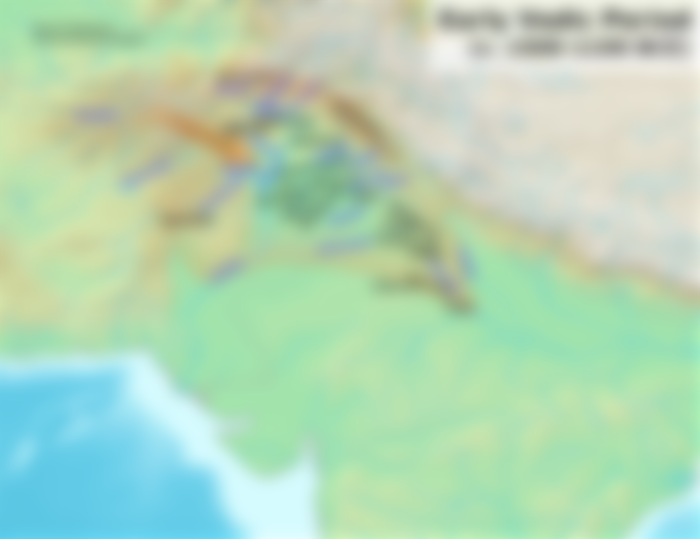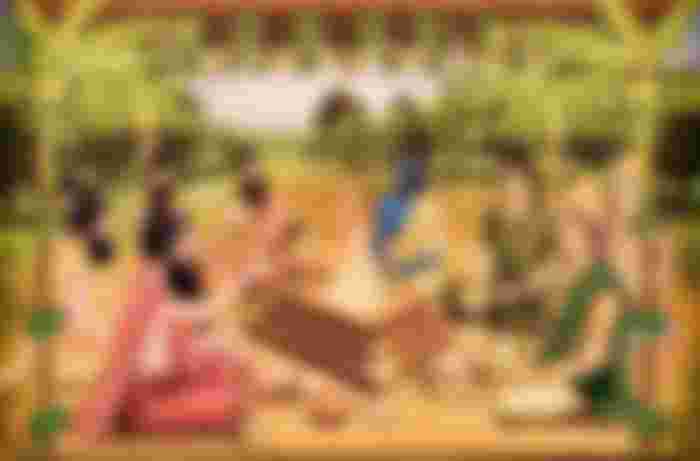In addition to the archaeological legacy discussed above, there remains from this period the earliest literary record of Indian culture, the Vedas. Composed in archaic, or Vedic, Sanskrit, generally dated between 1500 and 800 BCE, and transmitted orally, the Vedas comprise four major texts—the Rig-, the Sama-, the Yajur-, and the Atharvaveda. Of these, the Rigveda is believed to be the earliest. The texts consist of hymns, charms, spells, and ritual observations current among the Indo-European-speaking people known as Aryans (from Sanskrit arya, “noble”), who presumably entered India from the Iranian regions.
[bad iframe src]
Theories concerning the origins of the Aryans, whose language is also called Aryan, relate to the question of what has been called the Indo-European homeland. In the 17th and 18th centuries CE, European scholars who first studied Sanskrit were struck by the similarity in its syntaxand vocabulary to Greek and Latin. This resulted in the theory that there had been a common ancestry for these and other related languages, which came to be called the Indo-European group of languages. This in turn resulted in the notion that Indo-European-speaking peoples had a common homeland from which they migrated to various parts of Asia and Europe. The theory stirred intense speculation, which continues to the present day, regarding the original homeland and the period or periods of the dispersal from it. The study of Vedic India is still beset by “the Aryan problem,” which often clouds the genuine search for historical insight into this period.

That there was a migration of Indo-European speakers, possibly in waves, dating from the 2nd millennium BCE, is clear from archaeological and epigraphic evidence in western Asia. Mesopotamia witnessed the arrival about 1760 BCE of the Kassites, who introduced the horse and the chariot and bore Indo-European names. A treaty from about 1400 BCE between the Hittites, who had arrived in Anatolia about the beginning of the 2nd millennium BCE, and the Mitanni empire invoked several deities—Indara, Uruvna, Mitira, and the Nasatyas (names that occur in the Rigveda as Indra, Varuna, Mitra, and the Ashvins). An inscription at Bogazköy in Anatolia of about the same date contains Indo-European technical terms pertaining to the training of horses, which suggests cultural origins in Central Asia or the southern Russian steppes. Clay tablets dating to about 1400 BCE, written at Tell el-Amarna (in Upper Egypt) in Akkadian cuneiform, mention names of princes that are also Indo-European.
[bad iframe src]
Nearer India, the Iranian plateauwas subject to a similar migration. Comparison of Iranian Aryan literature with the Vedas reveals striking correspondences. Possibly a branch of the Iranian Aryans migrated to northern India and settled in the Sapta Sindhu region, extending from the Kābul River in the north to the Sarasvati and upper Ganges–Yamuna Doab in the south. The Sarasvati, the sacred river at the time, is thought to have dried up during the later Vedic period. Conceived as a goddess (seeSarasvati), it was personified in later Hinduism as the inventor of spoken and written Sanskrit and the consort of Brahma, promulgator of the Vedas. It was in the Sapta Sindhu region that the majority of the hymns of the Rigveda were composed.
The Rigveda is divided into 10 mandalas (books), of which the 10th is believed to be somewhat later than the others. Each mandalaconsists of a number of hymns, and most mandalas are ascribed to priestly families. The texts include invocations to the gods, ritual hymns, battle hymns, and narrative dialogues. The 9th mandala is a collection of all the hymns dedicated to soma, the unidentified hallucinogenic juice that was drunk on ritual occasions.
[bad iframe src]
Few events of political importance are related in the hymns. Perhaps the most impressive is a description of the battle of the 10 chiefs or kings: when Sudas, the king of the preeminent Bharatas of southern Punjab, replaced his priest Vishvamitra with Vasishtha, Vishvamitra organized a confederacy of 10 tribes, including the Puru, Yadu, Turvashas, Anu, and Druhyu, which went to war against Sudas. The Bharatas survived and continued to play an important role in historical tradition. In the Rigveda the head of a clan is called the raja; this term commonly has been translated as “king,” but more recent scholarship has suggested “chief” as more appropriate in this early context. If such a distinction is recognized, the entire corpus of Vedic literature can be interpreted as recording the gradual evolution of the concept of kingship from earlier clan organization. Among the clans there is little distinction between Aryan and non-Aryan, but the hymns refer to a people, called the dasyus, who are said to have had an alien language and a dark complexion and to worship strange gods. Some dasyus were rich in cattle and lived in fortified places (puras) that were often attacked by the god Indra. In addition to the dasyus, there were the wealthy Panis, who were hostile and stole cattle.
The early Vedic was the period of transition from nomadic pastoralism to settled village communitiesintermixing pastoral and agrarian economies. Cattle were initially the dominant commodity, as indicated by the use of the words gotra(“cowpen”) to signify the endogamous kinship group and gavishti (“searching for cows”) to denote war. A patriarchal extended family structure gave rise to the practice of niyoga (levirate), which permitted a widow to marry her husband’s brother. A community of families constituted a grama. The term vish is generally interpreted to mean “clan.” Clan assemblies appear to have been frequent in the early stages. Various categories of assemblies are mentioned, such as vidatha, samiti, and sabha, although the precise distinctions between these categories are not clear. The clan also gathered for the yajna, the Vedic sacrifice conducted by the priest, whose ritual actions ensured prosperity and imbued the chief with valour. The chief was primarily a war leader with responsibility for protecting the clan, for which function he received a bali(“tribute”). Punishment was exacted according to a principle resembling the wergild of ancient Germanic law, whereby the social rank of a wronged or slain man determined the compensation due him or his survivors.
[bad iframe src]
Later Vedic period (c. 800–c. 500 BCE)
The principal literary sources from this period are the Sama-, the Yajur-, and the Atharvaveda (mainly ritual texts), the Brahmanas (manuals on ritual), and the Upanishads(Upanisads) and Aranyakas (collections of philosophical and metaphysical discourses). Associated with the corpus are the sutra texts, largely explanatory aids to the other works, comprising manuals on sacrifices and ceremonies, domestic observances, and social and legal relations. Because the texts were continually revised, they cannot be dated accurately to the early period. The Dharma-sutra texts of this period became the nuclei of the socio-legal Dharma-shastras of later centuries.
Historians formerly assigned the two major Indian epics, the Mahabharataand the Ramayana, to this period, but subsequent scholarship has rendered these dates less certain. Both works are mixtures of the historical and the legendary, both were rewritten and edited, both suffered from frequent interpolations even as late as the early centuries CE, and both were later converted into sacred literaturewith the deification of their heroes. Consequently, important as they are to the literary and religious tradition, they are not easily identified with a historical period. The central event of the Mahabharata, whose geographic setting is the upper Ganges–Yamuna Doab and adjoining areas, is a war between two groups of cousins—the Kauravas and the Pandavas. Though the traditional date for the war is about 3102 BCE, most historians would prefer a later one. The events of the Ramayanarelate to the middle Ganges valley and central India, with later interpolations extending the area southward.
[bad iframe src]
The geographic focus of the later Vedic corpus moves from the Sapta Sindhu region into the Ganges–Yamuna Doab and the territories on its fringe. The areas within this land of the aryas, called Aryavarta, were named for the ruling clans, and the area encompassed within Aryavarta gradually expanded eastward. By the end of the period, clan identity had changed gradually to territorial identity, and the areas of settlement came eventually to form states. The people beyond the Aryavarta were termed the mlecchas (or mlechchhas), the impure barbarians unfamiliar with the speech and customs of the aryas.
The literature is replete with the names of clans. The most powerful among them, commanding the greatest respect, was the Kuru-Pancala, which incorporated the two families of Kuru and Puru (and the earlier Bharatas) and of which the Pancala was a confederation of lesser-known tribes. They occupied the upper Ganges–Yamuna Doab and the Kurukshetra region. In the north the Kamboja, Gandhara, and Madra groups predominated. In the middle Ganges valley the neighbours and rivals of the Kuru-Pancalas were the Kashi, Koshala, and Videha, who worked in close cooperation with each other. The Magadha, Anga, and Vanga peoples in the lower Ganges valley and delta were (in that period) still outside the Aryan pale and regarded as mlecchas. Magadha (Patna and Gaya districts of Bihar) is also associated with the vratyapeople, who occupied an ambiguousposition between the aryas and mlecchas. Other mleccha tribes frequently mentioned include the Satvants of the Chambal River valley and, in the Vindhyan and northern Deccan region, the Andhra, Vidarbha, Nishadha, Pulinda, and Shabara. The location of all these tribes is of considerable historical interest, because they gave their names to enduring geographic regions.
By the 5th century BCE, clan identity had changed to territorial identity, and the areas of settlement changed from chiefdoms to kingdoms in some cases. The state was emerging as a new feature. Assemblies such as the sabha and parishad continued as political institutions into later periods. The larger assemblies declined. Rudimentary notions of taxation were the genesis of administration, as were the ratnins (“jewels”), consisting of representatives of various professions advising the chief. A major transformation occurred in the notion of kingship, which ceased to be merely an office of a war leader; territorial identity provided it with power and status, symbolized by a series of lengthy and elaborate ceremonies—the abhishekha, generally followed by major sacrificial rituals, such as the ashvamedha. This ceremony was a famous horse sacrifice, in which a specially selected horse was permitted to wander at will, tracked by a body of soldiers; the area through which the horse wandered unchallenged was claimed by the chief or king conducting the sacrifice. Thus, theoretically at least, only those with considerable power could perform this sacrifice. Such major sacrificial rituals involved a large amount of wealth and a hierarchy of priests. The ceremonies lasted many days and involved a reciprocal economy of gift exchangebetween the chief and the priest, by which the latter received wealth in kind and the former established status, prosperity, and proximity to the gods.
The conspicuous display and consumption of these ceremonies have elicited comparison with the potlatch of the Kwakiutl and related North American indigenous peoples. The assumption of such sacrifices was that the clan had settled in a particular area, marking the end of nomadism. This led eventually to the claim of ownership by kings of the wastelands, although a ruler’s right to collect taxes was viewed not as a consequence of his ownership of wasteland but as his wage for protecting society. The new trends emphasized the importance of the priests and the aristocracy(Brahmans and Kshatriyas), who were the mainstay of kingship. The introduction, through royal sacrifices, of notions of divinity in kingship further strengthened the role of the priests. This was also the period in which kingship became hereditary.
The technology of iron, or krishna ayas (“dark metal”), as it was apparently called in later Vedic literature, and the migration into the Ganges valley helped in stabilizing agriculture and settlements. Some of these settlements along the rivers evolved into towns, essentially as administrative and craft centres. By the mid-1st millennium BCE the second urbanization—this time in the Ganges valley—was under way.
The development with the most far-reaching consequences for Indian culture is the structure of society that has come to be called caste. A hymn in the Rigveda contains a description of the primeval sacrifice and refers to the emergence of four groups from the body of the god Prajapati—the Brahmans (Brāhmaṇas), Kshatriyas (Kṣatriyas), Vaishyas (Vaiśyas), and Sudras (Śūdras). This is clearly a mythologized attempt to describe the origin of the four varnas, which came to be regarded as the four major classes in Indian society.
The etymology of each is of interest: Brahman is one who possesses magical or divine knowledge (brahman); Kshatriya is endowed with power or sovereignty (kṣatra); and Vaishya, derived from viś (vish, “settlement”), is a person settled on the land or a member of the clan. The derivation of the term Sudra, however, denoting a member of the group born to serve the upper three varnas, is not clear, which may suggest that it is a non-Aryan word. In addition to varna there are references to jati (birth), which gradually came to acquire a close association with caste and appears to mean the endogamous kinship group.
In the course of time the Brahmansbecame the preeminent priestly group, the intermediaries with the gods at the sacrificial rituals, and the recipients of large donations for priestly functions; in the process they acquired a number of privileges, such as exemption from taxes and inviolability. The Kshatriyas, who were to become the landowning families, assumed the role of military leaders and of the natural aristocracy having connections with royalty. The Vaishyas were more subservient, and, although their status was not as inferior as that of the Sudras, they appear to have been crucial to the economy. The traditional view of the Sudras is that they were non-Aryan cultivators who came under the domination of the Aryans and in many cases were enslaved and therefore had to serve the upper three groups. But not all references to the Sudras are to slaves. Sometimes wealthy Sudras are mentioned, and in later centuries some of them even became kings.
The traditional view that varnareflects the organization of Indian society has recently been questioned; it has been suggested that the rules of varna conform to a normative or presumptive model, and that the concept of jati is more central to caste functioning. This view is strengthened by the fact that the non-Brahmanical literature of later periods does not always conform to the picture of caste society depicted in the Dharma-shastras.



The literature is replete with the names of clans. The most powerful among them, Thanks for sharing